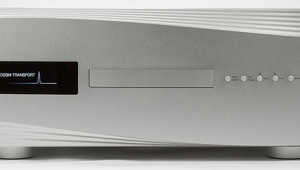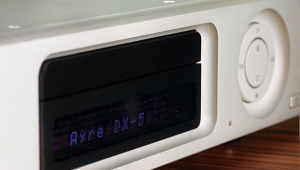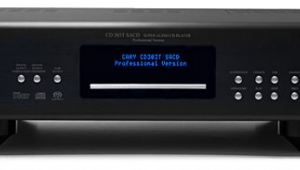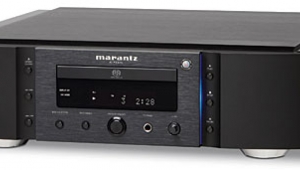| Columns Retired Columns & Blogs |
Sony SCD-1 Super Audio CD/CD player Measurements, CD player
Sidebar 4: Measurements, CD player mode
I tested the SCD-1 as a CD player using the CBS Test CD 1, the Pierre Verany Test CD, and a CD-R of my own test signals generated by the Audio Precision System One Dual Domain), and as an SACD player using a provisional Test SACD (TGZD 900005) supplied me by Sony. First, here are the measurements common to both modes of operation.
The maximum output level was 2.225V at 1kHz into a 100k load from the unbalanced outputs, 4.43V from the XLRs. There was a slight channel imbalance of around 0.15dB. The single-ended outputs are noninverting; the balanced outputs invert absolute polarity. The source impedance was a very low 33 ohms across the audioband from the RCA jacks and 396 ohms from the XLRs, the latter rising negligibly to 410 ohms at 20Hz.
And other than its leisurely reading of a disc's Table of Contents, I agree with Jonathan Scull that the Sony was an ergonomic delight to use.
The SCD-1 was just fair at reading damaged CDs, coping only up through track 30 on the Verany test disc without skipping, and dropping out once a revolution on track 31, which has 1mm gaps in its data. Channel separation on CD replay was superb, the crosstalk being below the noise floor below 1kHz, and rising at 6dB/octave to around -100dB at 20kHz (slightly less in the L-R direction than in the R-L).
The Sony's CD frequency response varied according to the digital filter selected. Fig.1, for example, shows the response at -12dBFS with the "std" filter (top traces), and using "dfil-1" (bottom traces). The former is conventionally flat in the audioband; the latter rolls off to -3dB at 20kHz, somewhat akin to the filter used by Wadia and Pioneer players. Fig.2 shows the response with filters "dfil-2" through "dfil-4." "3" is at the top, and appears to be a very sharp brickwall (sharper than "std"). "2" is similar to "1," but with a gentler and earlier HF rolloff. "4" has significant passband ripple, which, all things being equal, should result in the most time-domain dispersion. By contrast, "1" and "2" should have minimal dispersion. Note that as well as their differences in top-octave response, the filters change absolute level, admittedly to a small extent, but this change will be audible.

Fig.1 Sony SCD-1, unbalanced CD frequency response at -12dBFS with "std" digital filter (top) and "dfil-1" (bottom). (Right channel dashed, 0.5dB/vertical div.)

Fig.2 Sony SCD-1, unbalanced CD frequency response at -12dBFS with (from top to bottom): "dfil-3," "dfil-4," and "dfil-2." (Right channel dashed, 0.5dB/vertical div.)
All of these responses were plotted from the single-ended outputs. The balanced response was identical, while playing back pre-emphasized data resulted in a very slight peak in the top octave (fig.3).

Fig.3 Sony SCD-1, unbalanced CD frequency response at -12dBFS with de-emphasis. (Right channel dashed, 0.5dB/vertical div.)
- Log in or register to post comments




































